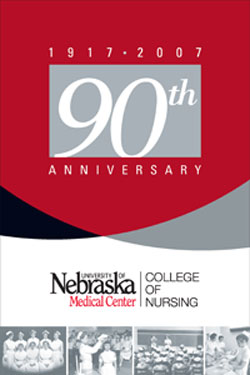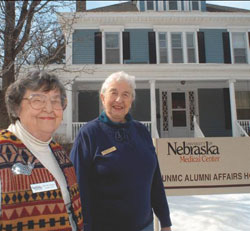 EDITOR’S NOTE: The following is a story from the spring 2007 edition of the College of Nursing publication, Advances. This and other stories from the publication will run in UNMC Today in commemoration of the college’s 90th anniversary. Click here to see the entire Advances newsletter online.
EDITOR’S NOTE: The following is a story from the spring 2007 edition of the College of Nursing publication, Advances. This and other stories from the publication will run in UNMC Today in commemoration of the college’s 90th anniversary. Click here to see the entire Advances newsletter online.
Talk to nurses who worked with children in the 1950s and one subject is bound to come up — polio.
A 1944 College of Nursing graduate, Dorothy Patach worked through two polio epidemics.
“We performed all patient care through the doors and windows of the iron lung,” Patach said. “You had to work fast so that the machine wouldn’t lose pressure.”
Malvina “Vinn” Brunn Stephans, a 1951 graduate, spent two years caring for children in iron lungs.
Stephans also remembers many children with serious burns. Patach added that childhood diseases rarely seen today were then common, including measles, chicken pox, mumps, diphtheria, tuberculosis and scarlet fever.
What they didn’t see was an epidemic of childhood obesity.
Patach attributes today’s overweight children to pervasive junk food and a popular culture that is heavy on sedentary habits and light on meal planning, sound nutrition and vigorous activity.
“When I was growing up, we always sat down to an evening meal together,” Patach said. “Plus, school children had the opportunity to walk home for lunch each day so they were getting both a healthy meal and exercise.”
Patach also thinks children aren’t encouraged to do any physical work around the house.
“I grew up in the city but I still had plenty to do outside,” she said. “I could paint or mow the yard or pull weeds. We didn’t have organized sports like they do today, but I took dance lessons and went ice skating.”
 |
College of Nursing Alumni, Doroth Patach, class of 1944, and Malvina “Vinn” Brunn Stephans, class of 1951. |
“A big problem is lack of exercise,” she said. “Schools cut back on gym classes and parents use TV, computers and video games as babysitters.”
Betty Huttenmaier Rath, a 1949 College of Nursing graduate, said earlier generations of children went outside to play instead of sitting in front of a screen. Typical snacks were a piece of fruit, a peanut butter sandwich or a glass of milk, she said, and one cookie was a big treat.
Stephans said food choices contribute to an increase in another disease in children and adults.
“We didn’t see diabetes like they do now,” she said. “It’s largely because of the food system today. We simply didn’t have as much access to sweets, processed foods and fast foods loaded with sugar and fat.”
The three alumni shared these other reflections on changes in health care:
- Simple things could contribute to higher rates of asthma and upper respiratory infections. “Buildings are so closed up today,” Patach said. “We were able to open windows and give patients fresh air, although we never put patients in a draft. We hung draft sheets or screens around them.”
- Patients, especially new mothers, go home too soon, Rath said. She taught new mothers classes at UNMC and believes that next-day discharge is too fast, mostly for the baby. Although surgical procedures are less traumatic today, she feels that recovery time is short. Patach added: “Patients used to be admitted the night before surgery so they could rest up and get ready.”
- “Meds were so easy then,” Stephans said. Added Patach: “We didn’t have as many medications or as many reactions.”
- They all recall a line drawn between physical and mental health. “Today’s care reflects that mental, spiritual and physical health are intertwined,” Stephans said. All three also cited today’s early detection methods in changing cancer outcomes. “Mammograms are a great tool,” Rath said. “I’m surprised at the number of women who don’t routinely get a mammogram.”
The three women concur on another point — their nursing degrees opened doors throughout their careers.
Patach was assistant operating room supervisor and clinical instructor at UNMC until 1948 when she became an operating room supervisor at Clarkson Hospital on the medical center campus.
She worked at Jennie Edmundson School of Nursing in Council Bluffs, Iowa, as nursing arts instructor until 1959. Her next 30 years were spent at the University of Nebraska at Omaha, first as director of nursing and allied health and then as assistant to the dean of arts and sciences.
Stephans balanced nursing with raising three daughters. She worked in Omaha at Children’s Memorial Hospital, Hattie B. Munroe Center, University of Nebraska at Omaha College of Adult Education, Clarkson Hospital, and the University of Nebraska Family Planning Clinic. She also worked in the emergency room at Shriners’ Orthopaedic Hospital in Salt Lake City and at Omaha’s Catholic Charities, where she used her associate degree in chemical dependency counseling.
Today she is a parish nurse at Omaha’s Kountze Memorial Lutheran Church.
Rath taught obstetrical and gynecologic nursing at Boston Lying-In Hospital, Barnes Hospital in St. Louis and Long Island College in Brooklyn, N.Y. She returned to UNMC in 1960 and taught classes for new mothers until 1976.
“Nursing today offers more possibilities and flexibility than ever before,” she said. “There is nothing more rewarding than helping people and I encourage young students to explore nursing as a career.”